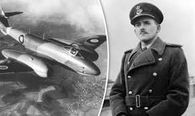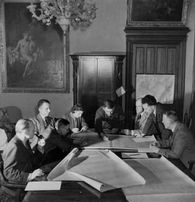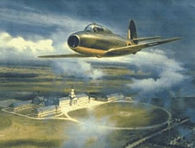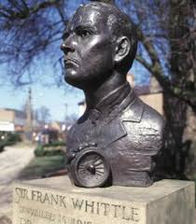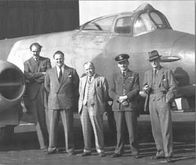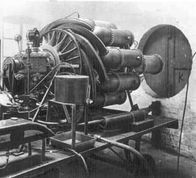Sir Frank Whittle
Lutterworth and District Museum is proud to have a Whittle W2/700 jet engine as part of its collection. The engine, which is on loan from Leicestershire Museums, is in “cut away” format which means that the internal workings of the engine are on display.
The collection also includes a model of the jet engine test bed, a copy of the original jet engine patent filed by Frank Whittle in January 1930, examples of the combustion chambers and an actual bottle of Champagne (alas empty!) that was drunk by Power Jets employees to celebrate the successful first test of the jet. The bottle is signed by Frank Whittle and the employees.
Frank Whittle was born in Newcombe Road, Coventry on 1st June 1907. He attended the local Earlsdon council school and then, having secured a £10 a year scholarship, he went to Leamington College. Franks interests were centred around the reference library, reading up on his favourite topics such as physics, chemistry and engineering, particularly aircraft engineering, and it was around this time that he became familiar with the principles of the steam turbine engine and the potential of a turbine as a prime mover. Frank hated sport, and fortunately his teachers recognised his potential and allowed him extra time in the laboratories rather than forcing him on to the playing fields.
Frank decided at the age of 14 that he wanted to join the RAF and become a pilot, and at 15 he applied to become an apprentice, reporting to Halton Camp in January 1922. Although he passed all of the exams, he was rejected due to poor physique, being short in stature and slight in build. Undeterred, he took the advice of a sympathetic Sergeant and followed a special diet and exercise regime which resulted in him growing by 3 inches in height. He reapplied when he was 16 and was again turned down, and told not to apply again due to his previous medical report. Frank Whittle was not to be defeated – he continued on the diet and exercise regime, and applied for a third time, however this time failed to mention his previous two applications. His application was successful!
In 1923, Frank reported to Cranwell as “No 364365 Boy Whittle F” to begin his RAF apprenticeship as a fitter in No4 Apprentice Wing. As an apprentice Frank displayed outstanding qualities in engineering and design, while his hatred of sport grew. He joined the Model Aircraft Society, which was accepted as an alternative to sport, and spent most of his spare time working on the models, to the extent that officers noticed him for the successful flights of the models, and visitors were often taken to see the models being flown. In 1926, at the end of his apprenticeship, he was awarded a cadetship at the RAF College at Cranwell to train as a Pilot Officer. At the end of his third term as a cadet, Frank wrote a thesis entitled “Future Developments in Aircraft Design” in which he first proposed the theory that a gas turbine could be used to power an aircraft. His 2 years as a Flight Cadet ended in 1928 and he passed out with distinction, also winning the coveted Abdy Gerrard Fellowes Memorial Prize for Aeronautical Sciences.
Posted to Operational Squadron No.111 as a Pilot Officer, he moved to the Central Flying School in 1929 to qualify as a flying instructor. During this time he had been developing his ideas for the propulsion of aircraft, while recognising the limitations of the internal combustion engine at altitude, along with the limitations of propeller speed. The Air Ministry had heard about Franks ideas and an appointment was made for him to meet Dr AA Grifiths at the Royal Aircraft Establishment. Griffiths was already interested in the subject and had been working on an engine of his own – he questioned Franks calculations and gave no encouragement, reporting back to the Air Ministry that Frank’s turbojet connect held little merit and warranted no further attention. Despite this, and at the suggestion of a fellow Flying Officer Pat Johnson, Frank took out a patent on his jet engine on 16th January 1930, aged only 22 and a Flying Instructor in the RAF.
Frank was transferred to the Marine Aircraft Establishment as a test pilot in 1931, and moved to the Officers School of Engineering in 1932 to study aeronautical engineering, achieving 98% in all exams. In 1934 he was then allowed to study Mechanical Sciences at Peterhouse College, Cambridge, at the end of which he achieved a First Class Honours Degree. However, while at Cambridge his patent on the jet engine expired and he couldn’t afford the £5 renewal fee. Unfortunately, as the President of the Air Council did not consider any need for secrecy, the patent was published with copies being purchased by the German Air Ministry and circulated via technical journals to engine manufacturers, air frame designers and researchers. Meanwhile, the German Air Ministry added the idea to their list of alternative methods of aero propulsion.
Despite this, the Air Ministry agreed to give Frank a research fellowship for a further year at Cambridge so that he could concentrate on his turbo jet design. At around this time, Frank received a letter from an ex room-mate, Rolf Dudley-Williams, who along with his friend James Tinling offered to raise £50,000 for the development of Frank’s design. By 1935, the finances were in place and in 1936 the company called “Power Jets” was created, with Whittle, Dudley-Williams and Tinling holding 49% of the shares. Frank approached a Rugby company called British Thomson Houston (BTH) to prepare the initial design drawings, finishing the final drawings himself, and by the end of 1936 the design work was largely complete.
Known as the WU, Frank successfully ran the engine for the first time at the British Thomson-Houston works at Rugby on 12th. April 1937. This was only four years after the first successful bench test of the Rolls Royce Merlin engine that was to feature so successfully for the RAF in World War II.
Unfortunately, in its early runs the engine showed a tendency to behave erratically so BT-H suggested that it might be safer if testing was continued up the road at a disused foundry they owned in Lutterworth. Power Jets moved into the Ladywood Works on the east side of the Leicester Road at the beginning of 1938, the workforce consisting of Whittle and an assistant, Victor Crompton, with some BTH fitters and test hands.
The need to replace certain failed components resulted in delays, with testing resuming on 17th June 1939 and the engine was soon reaching speeds of 16,000 rpm, much higher than any achieved previously. Rooms were rented at Brownsover Hall, a large house on the northern edge of Rugby, and Whittle moved his office there, taking with him his senior design staff. The main Design Drawing Office remained located in a large wooden hut at the Ladywood Works. During this time Whittle received many visitors, not least Air Chief Marshall Sir Hugh Dowding, Commander in Chief of Fighter Command. By the end of 1939 the Air Ministry finally acknowledged that Franks ideas were feasible, and a contract was issued to Power Jets to develop a flight engine, known as the W1, to be built on their behalf by the Rover company. The contract to build a plane in which to fit the engine was given to Gloster Aircraft Company, and they developed the E28/39.
By April 1941 a test version of the flight engine – W1X – was assembled and run at Lutterworth just as the first of the Gloster Whittle E28/39s was completed. Sir Frank Whittle ensured that Britain entered the Jet age when, on 15 May 1941, the Gloster-Whittle E 28/39, propelled by one of his jet engines, flew successfully from Cranwell, England.
In January 1942 Ernest Hives, a director of Rolls-Royce, visited Lutterworth following a discussion with Whittle about a possible tie-up between the two companies. In March 1942, Whittle had commenced a redesign, labelled the W2/500, and Whittle’s plan now was that Rolls-Royce would put the W2/500 into production to power the new Meteors. Meanwhile much of Power Jets work was being transferred to a new facility 7 miles away at Whetstone and its total staff had risen to over 1000.
Whittle was awarded a CBE in the 1944 New Year Honours List and 6 days later, bowing to US pressure, the existence of the jet engine was made public, making Whittle a national hero. He was also promoted to Air Commodore. At this time, Power Jets was nationalised by the UK government.
In October 1945 Whittle was at last able to make several flights in a Meteor 1 powered by an engine that he had himself designed – the W2/700. It is an example of this engine that is on display at the Lutterworth and District Museum. However, still a serving officer, in 1946 Frank was removed from the design and development of jet engines. Disillusioned, Frank resigned as a Director of Power Jets and resumed normal RAF duties. Most of the small band of dedicated engineers and designers which Whittle had built up (henceforth to be known as “The Reactionaries” and to meet informally once a year for the next 50 years at The Hind Inn prior to closure) dispersed a few weeks later to pursue separate careers in industry.
Whittle retired from the RAF in 1948 and was knighted by King George V in the same year. He became a consultant and technical advisor to aviation companies in the 1950’s. Later he went to work in the USA and following his marriage to an American wife he moved his home to the USA in 1976. He was awarded the Order of Merit by Her Majesty the Queen in 1986 and died in America in 1996.
Sir Frank was a dedicated Englishman and exceedingly proud of his country. Furthermore, he had tremendous respect for the RAF, which he held in high esteem and considered to be the finest service anywhere in the world. He always gave credit for his success, both privately and publicly, to the training that he received at Cranwell, both as an apprentice and as a cadet. One thing he did always regret, however, was that jet aircraft did not make a major contribution to Britain’s war effort, as he had hoped.
For more information on Sir Frank Whittle, visit the Sir Frank Whittle website at https://frankwhittle.co.uk/
